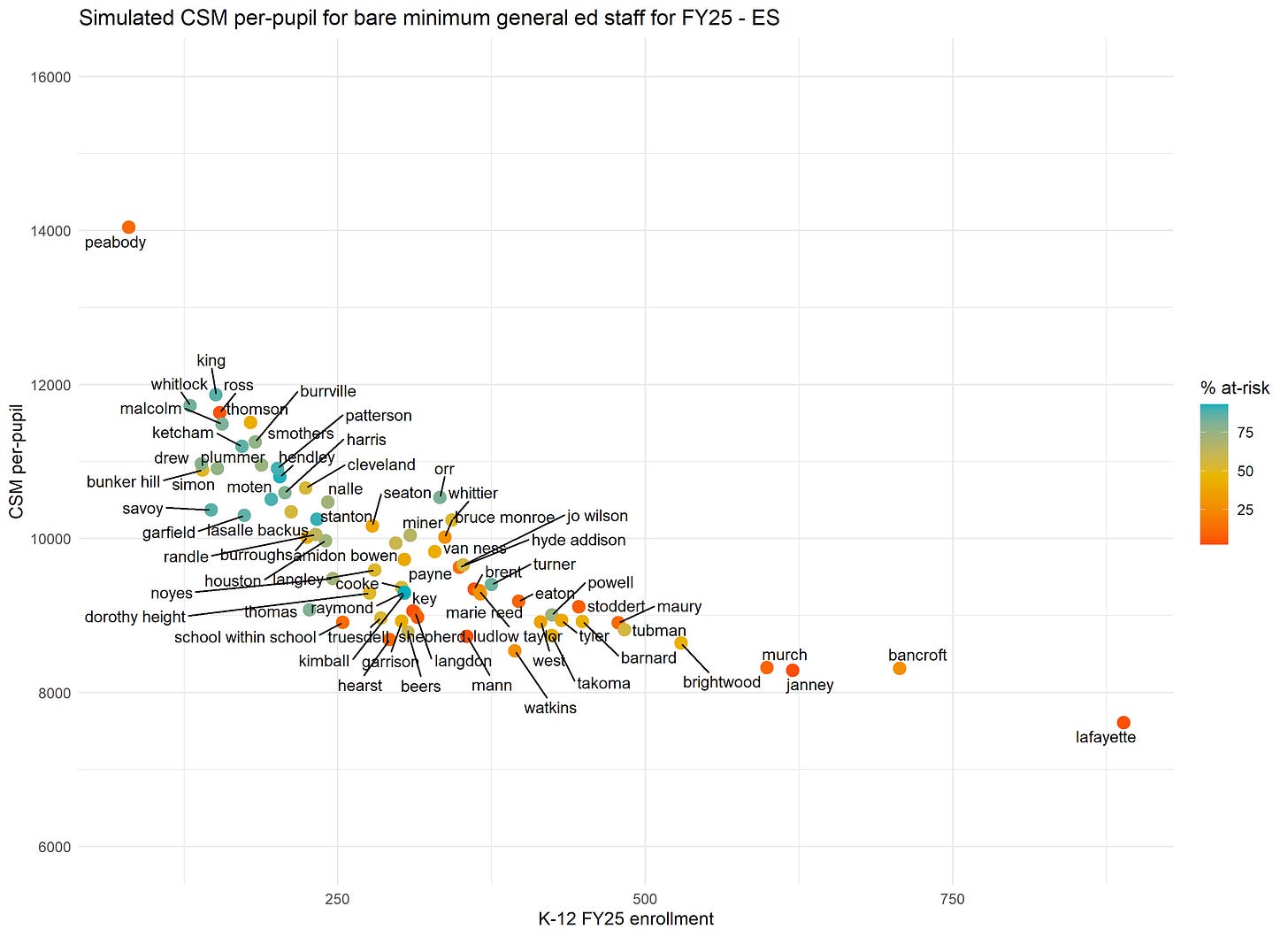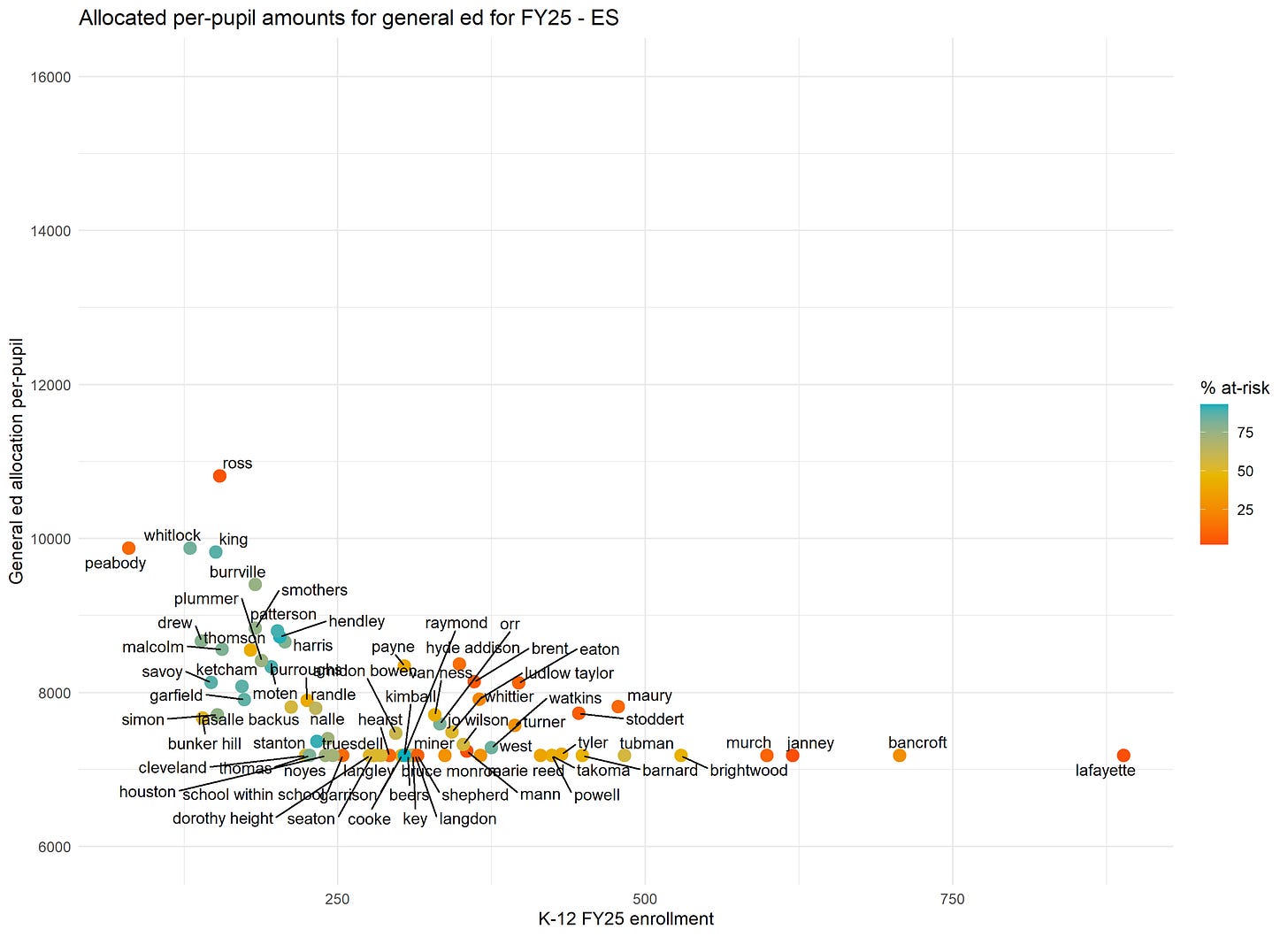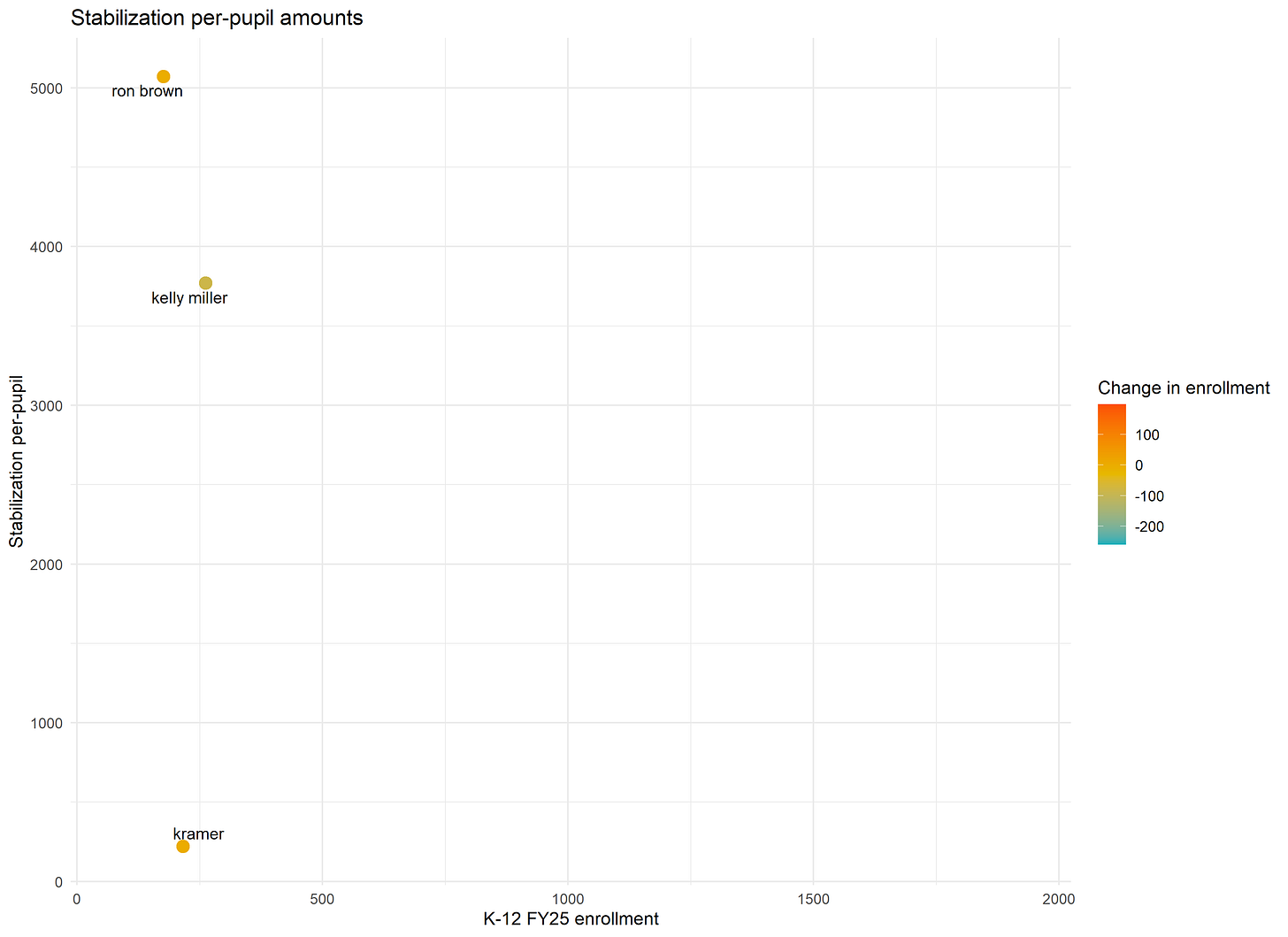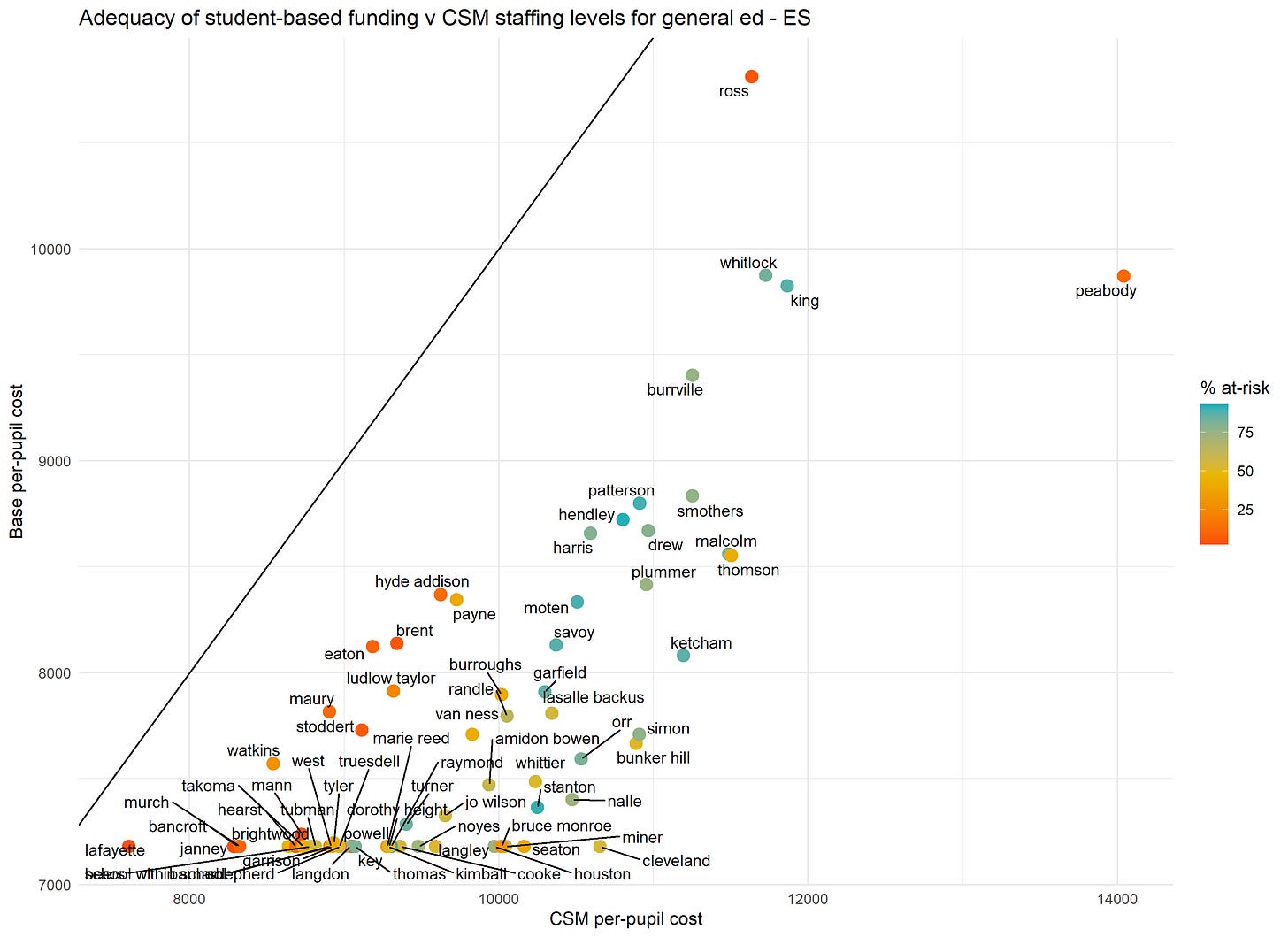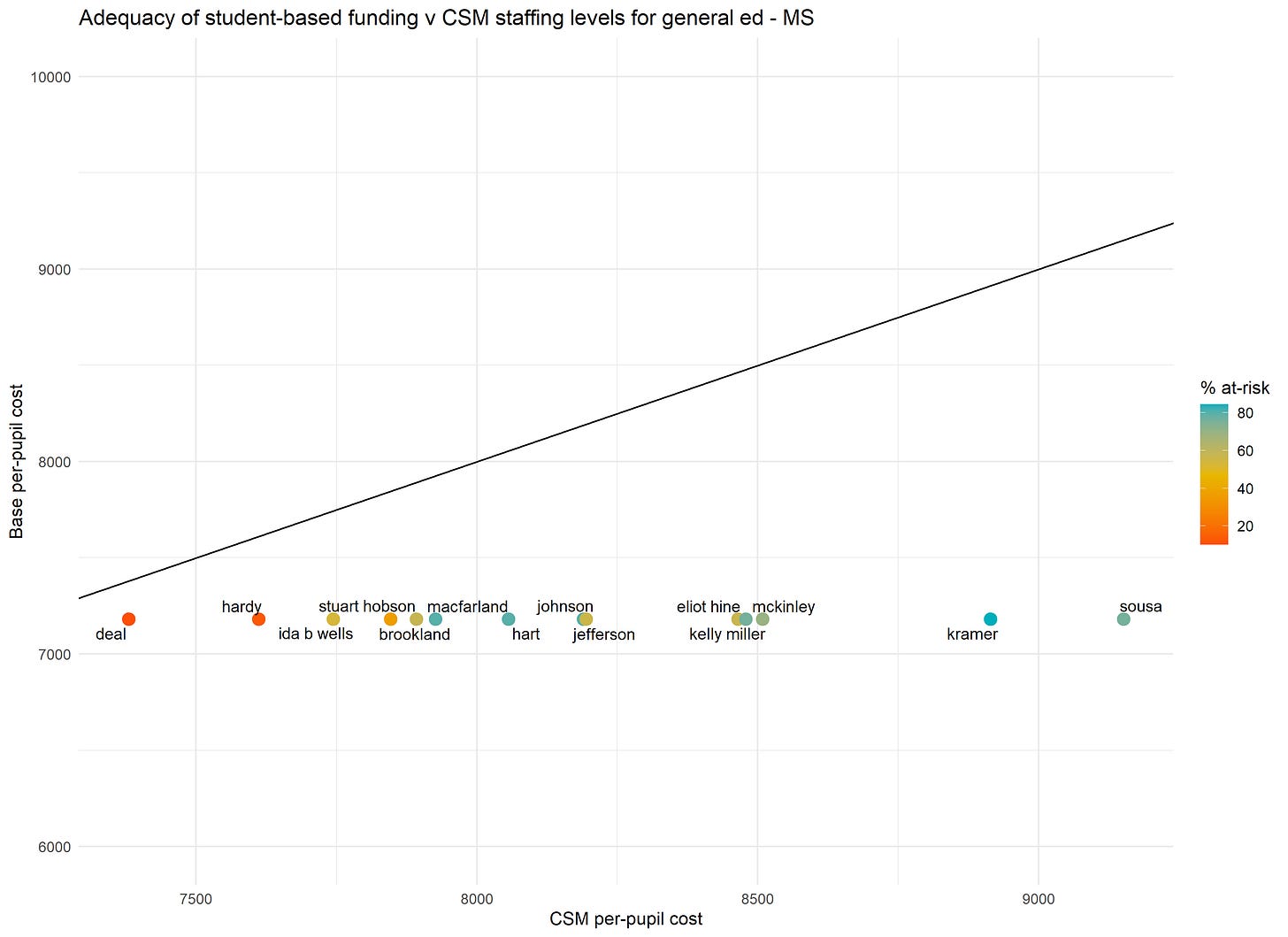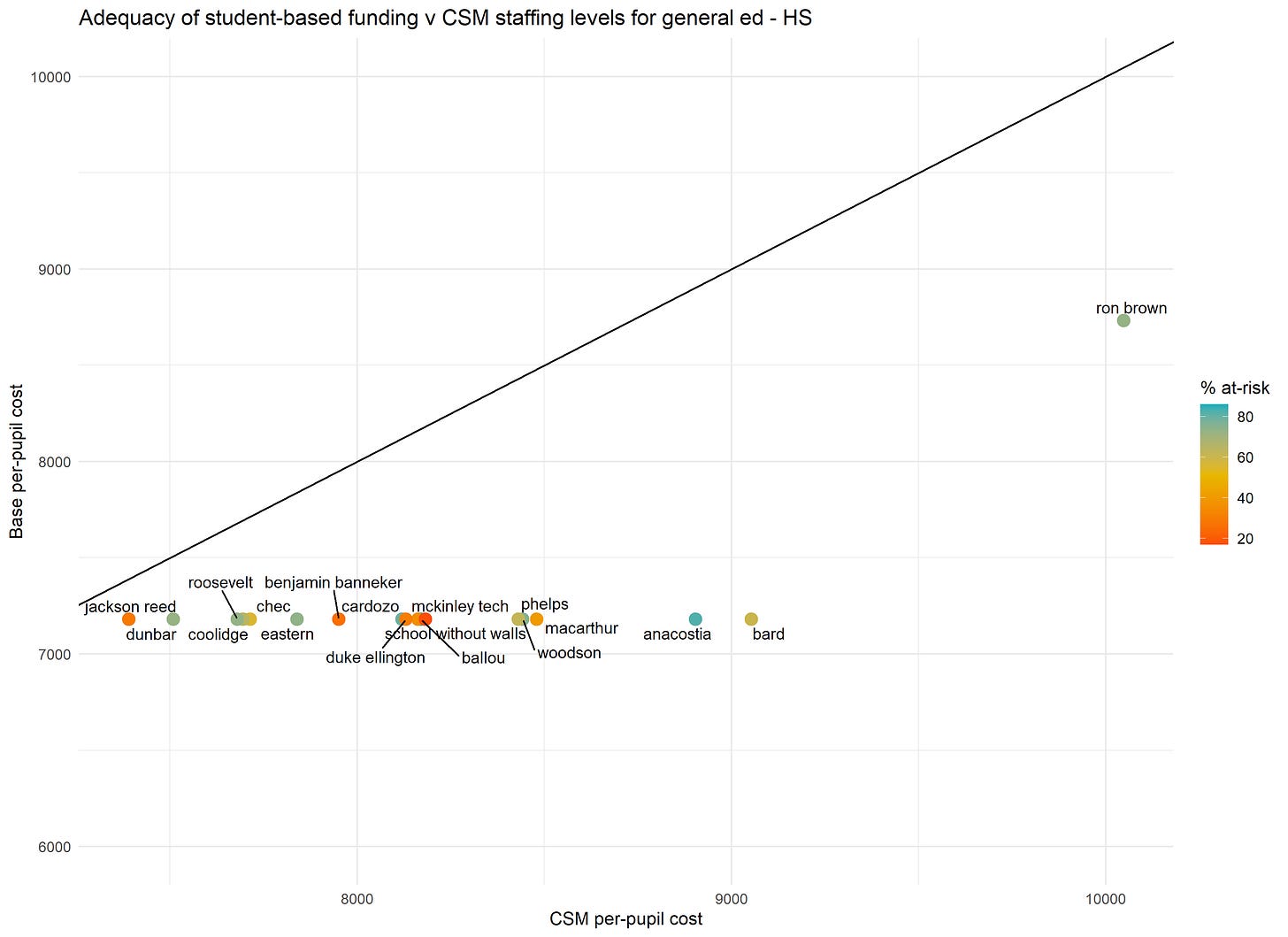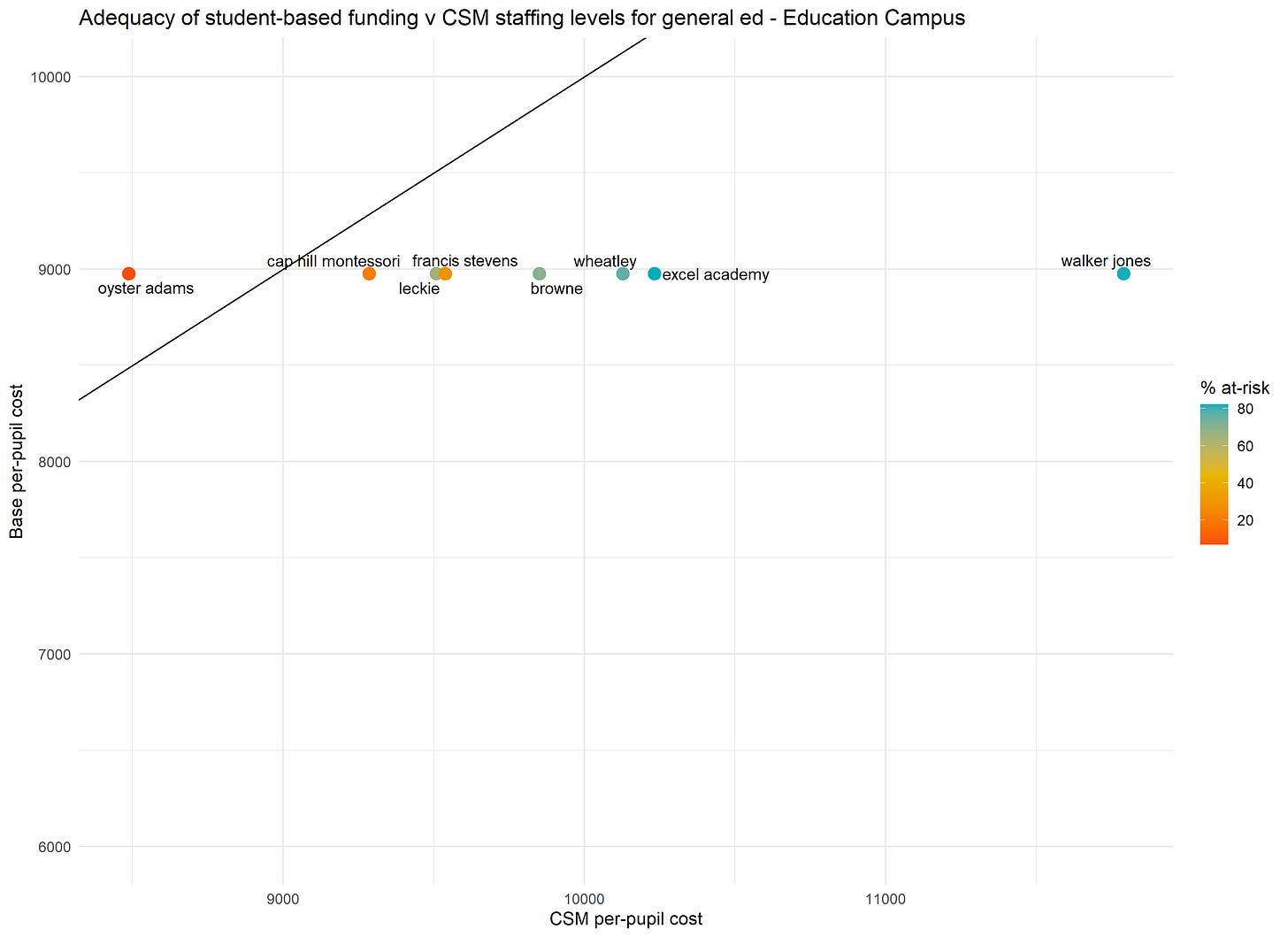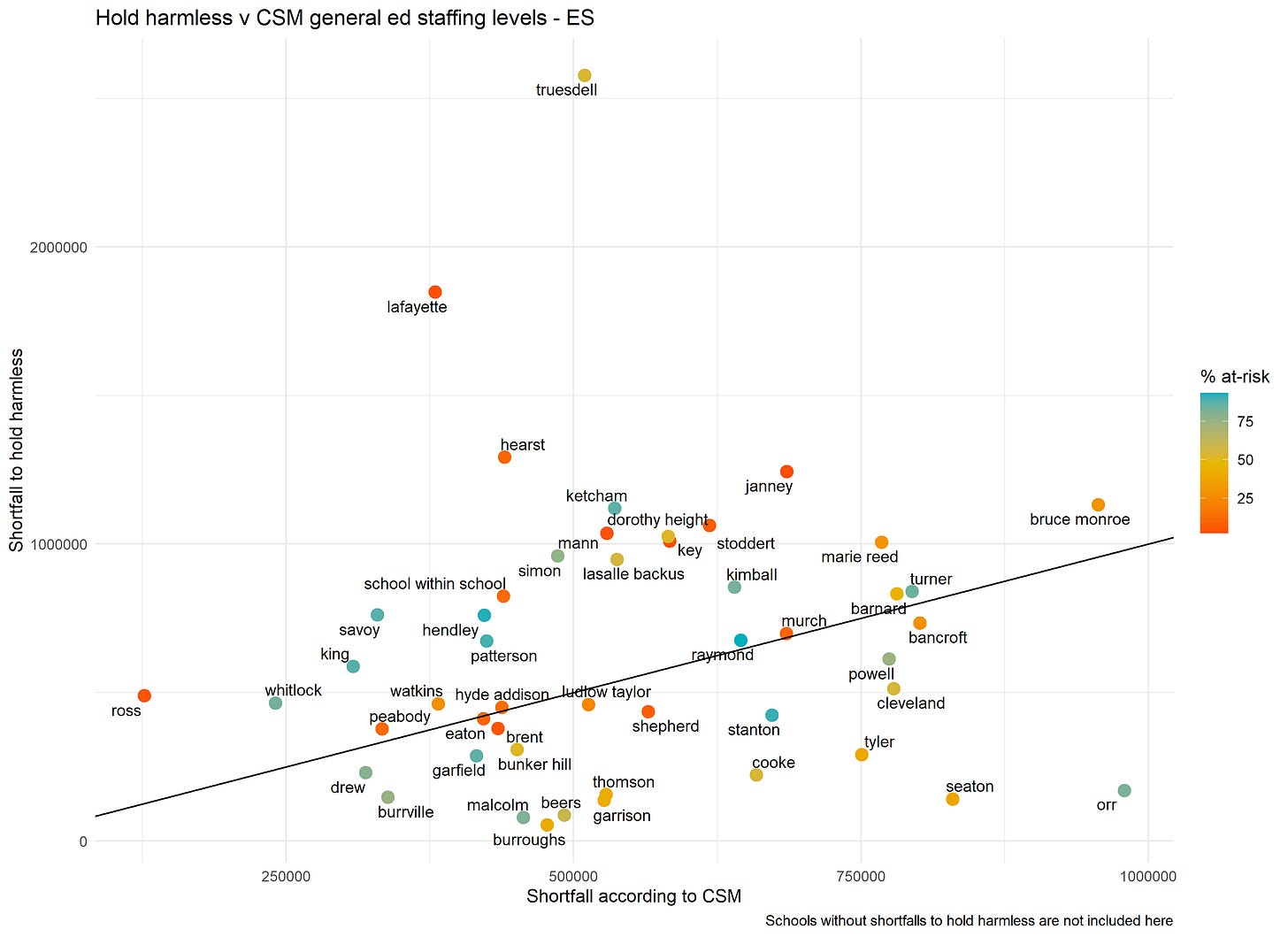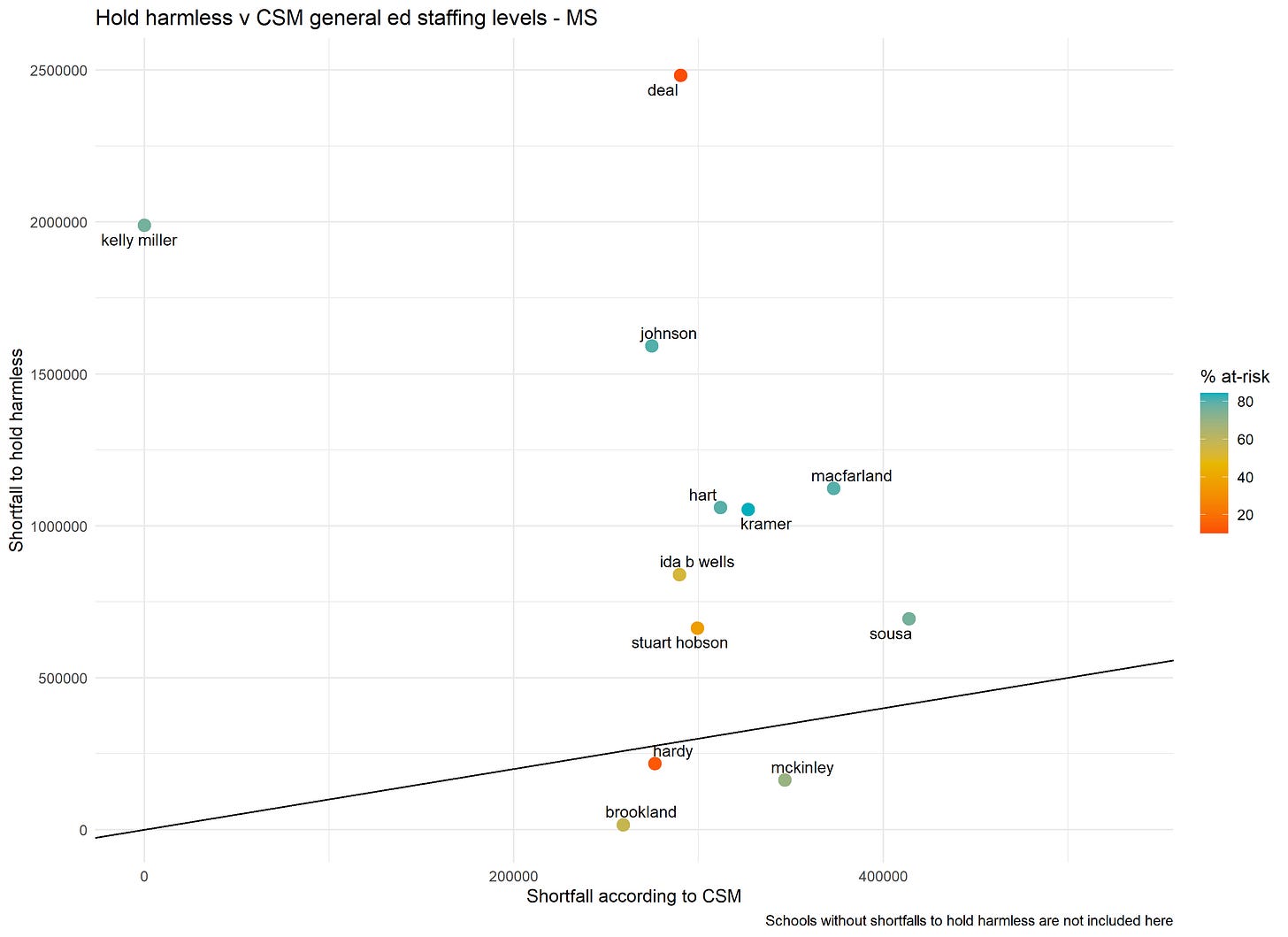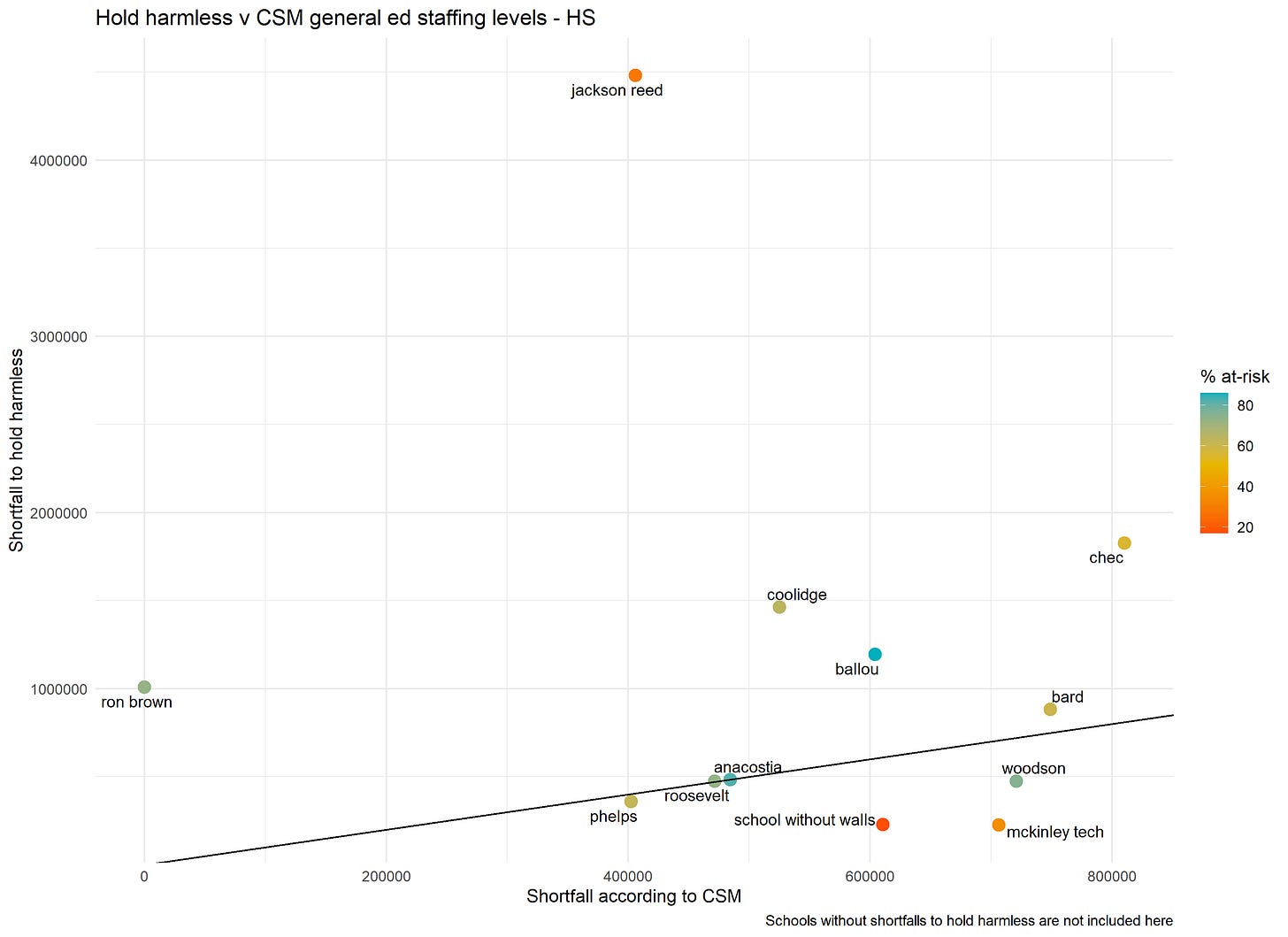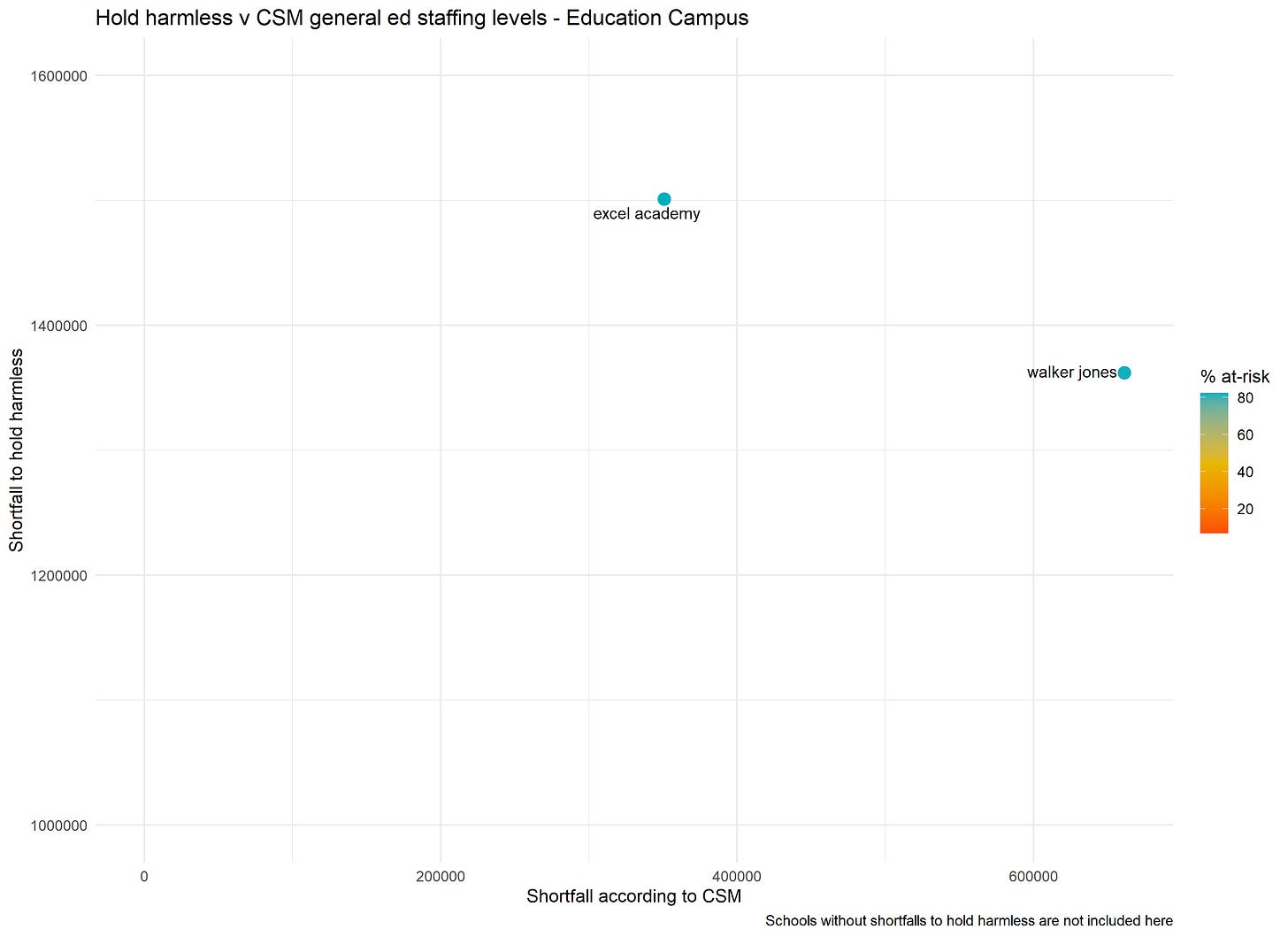DCPS Budgets, Unpacking Stability, Adequacy, & Equity
FY25 Version
Mary Levy estimated that two-thirds of DCPS schools are losing purchasing power and many are facing staff cuts for the 2024-25 year. Moreover, about half of the schools losing purchasing power have increased projected enrollments for next year. As Levy explains, this is largely because costs increased faster than increases in the budget allocations, and this generally happens every year.
But what I also wanted to know is, to what extent are schools facing shortfalls to fund general education as a result of DCPS’s new budget model? And, to what extent are some schools facing shortfalls because they had more staff than other schools to begin with, above and beyond the base? General education includes things like classroom teachers and other staff who support all students in the school. It does not include special education and English learner staff who are allocated based on the number of special education and English learner students, and who are largely funded by federal funds.
It was not lost on me that when passing the Schools First legislation, the Council of DC prioritized stability, as opposed to equity or adequacy. Don’t get me wrong - I would rather have stable and inequitable budgets over unstable AND inequitable budgets any day. But the focus on stability in particular was aligned with protecting what schools already had and not questioning why some schools had what they had in the first place.
To try to disentangle some of this, Mary Levy and I calculated to what extent the new budget model covers most of the bare minimum general education staff according to DCPS’s prior comprehensive staffing model (CSM), and to what extent schools facing losses in purchasing power had more than the CSM to begin with. (See data notes for specifics). But let’s back up…
For all schools, the CSM allocated grade-level teachers to schools according to projected enrollments in each grade, and a few schoolwide personnel according to the projected enrollment for the school — such as instructional coaches, assistant principals, related arts teachers, kindergarten aides, and office staff. As you can see, the CSM set very different staffing levels for small versus large schools due to economies of scale. (For this analysis, we removed schoolwide personnel that are also granted in the new DCPS budget model, such as principals and administrative aides, so we can make apples-to-apples comparisons. We also excluded PK teachers, since these are funded separately.)
Note the graphs overstate the costs for elementary schools with large PK enrollments.
DCPS’s new budget model funds schools using a weighted student formula for most general ed positions, plus a safety net that is supposed to ensure each school has enough grade-level teachers. Under the new budget model, large and small schools have more similar amounts of per-pupil spending on general ed staff than they did under the CSM staffing levels. There are still differences in per-pupil spending across schools because of other, required positions, differences in grade-level enrollments, and specialty programs, which are not captured here.
Note the graphs overstate the costs for elementary schools with large PK enrollments.
In addition to base funding, DCPS adds “stabilization” funding for schools facing large swings in enrollment, based on the 95% rule, or that no school can receive less than 95% of its budget from the previous year.
Question #1: Is the new student-based funding model for most general ed staff adequate compared to the CSM?
In other words, does the new budget model fund the very bare minimum to cover general ed teachers, assistant principal, instructional coach, etc. in its base allocations? And the answer is no. In virtually all schools, the base funding (student-based weighted formula and safety net) is less than the CSM staffing levels. The line shows the CSM funding, so schools below the line (vertically or to the right of the line) are receiving less funding for the bare minimum general ed staff than was allocated by the CSM.
Note the graphs overstate the costs for elementary schools with large PK enrollments.
Note the graphs overstate the costs for elementary schools with large PK enrollments.
This means that nearly all schools will have to redirect some of their limited, flexible weighted student “at-risk”, special education, English learner, and early childhood funds to cover general education costs. This also means then that these schools won’t be able to fully use these weighted student funding streams to fund additional supports for the students for which the money is intended. DCPS has a long history of using “at-risk” funds to supplant general education, even though these funds are supposed to be supplemental by law. There is a lot of improvement on this point, but these supplemental funds are still being used to supplant general education costs.
Question 2: Are schools facing shortfalls to hold staff harmless doing so because of the inadequacy of the student-based funding, or because they previously received more staff than other schools?
The answer is both. The graph below shows the shortfalls to hold staff harmless from last year (y-axis). The graph also shows the shortfall under the simulated CSM staffing levels for the minimum general ed staff (x-axis). Keep in mind that schools may have received specialty funds, above and beyond the minimum, that is not captured in the CSM minimum. Any school above the line vertically has more staff than the CSM minimum staffing level, and any school under the line has less staff than the CSM minimum staffing level. The graphs show that for schools facing shortfalls to hold harmless, about 60% had additional staff above and beyond the minimum staff allocated to all schools under the CSM. At the same time, the graphs also show that all schools facing shortfalls to hold harmless had inadequate funds for the minimum general ed staff under the new budget model. So, while DCPS’s new budget model is underfunding the minimum general ed staff for all schools, most schools facing shortfalls to hold harmless also had more staff than other schools to begin with.
To be clear, the CSM is the bare minimum, and this is not desirable for any school. But if some schools receive extras — such as additional related arts teachers, world language teachers, science teachers, and specialty programs — then shouldn’t we at least consider who has access to these resources, and if the extra resources are allocated equitably? I do not begrudge any school for having additional personnel, but if it leads to vastly unequal opportunities (and we know that it does from the submitted budgets), then we should advocate not only that DCPS maintain budget stability, but also that DCPS funds additional staff in all schools so that all students have equal opportunity to the same resources.
To wrap up, 66% of schools are facing a shortfall to hold harmless, and some schools are facing a substantial shortfall. Schools are facing shortfalls because 1) DCPS is not adequately funding the bare minimum (especially given increases in staff costs), and 2) some schools received more resources than other schools in the past. Nearly all schools will have to redirect some of their limited, flexible student-weighted funds to cover general ed costs.
So what now? We need to advocate that DCPS gives schools enough money to fund the bare minimum, without schools needing to use their flexible “at-risk”, special education, English learner, or early childhood weighted funding. This is an easy talking point, and it will help with the budget shortfalls. While we should continue to advocate for stability, we should also advocate for equity in additional resources across all schools, above and beyond the base.
So, adequacy + stability + equity? Can we advocate for all three?
A special thanks to Mary Levy for her collaboration and insights on this post.
Data notes:
I pulled the projected enrollments for each grade from Council oversight documents here: https://lims.dccouncil.gov/Hearings/hearings/244
CSM simulations:
For elementary grades, we divided grade-level enrollment by 25 and rounded up to determine the number of teachers needed to comply with the teacher’s union contract. PK teachers were not included because they are funded separately.
For middle and high school grades, we divided grade-level enrollment by 21 and rounded up, to account for all rotations and teacher planning periods.
Specials teachers were also calculated for PK-5 grades according to the CSM: 3 for enrollments <400, 4.5 for enrollments between 400 and 599, and 5.5 for enrollments >=600.
1 instructional coach for every school.
1 clerk for every 400 students.
1 business manager for schools with >300 students, and 0.5 business manager for schools with <=300 students.
For elementary schools, 1 assistant principal for every 400 students. If a school had <400 students, then a prorated amount of an assistant principal. If a school had <300 students, then no assistant principal.
For middle and high schools and education campuses, 1 assistant principal for every 300 students. If a school had <300 students, then a prorated amount of an assistant principal.
For high schools only, one registrar and one attendance counselor.
For education campuses with >500 students, at least two instructional coaches and two assistant principals given the two grade bands and large scope in expertise in a combined elementary and middle school. This is a variant of the CSM meant to provide realistic assumptions about what the bare minimum staffing levels needed.
As noted above, positions such as the principal and administrative aide and PK teachers were not included in the CSM calculation because these positions are allocated separately under the new budget model. As a result, the graphs overstate the costs for elementary schools with PK students because related arts teachers and schoolwide personnel serve PK students too.
Adequacy:
The base funding amounts came from student-based weighted funding and the safety net in the FY25 initial allocations, divided by the projected K-12 enrollment. (PK is funded separately.)
Shortfall:
The budget shortfalls to hold staff harmless were estimated by Mary Levy.
The budget shortfalls according to the CSM were calculated by the base funding as in the CSM simulations minus the base funding (student-based weighted funding + safety net) allocated by the new budget model.


